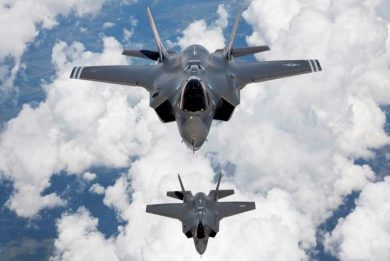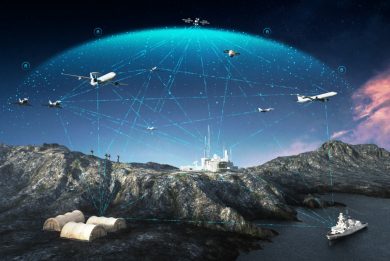Patria Arctic Event 2025: Task Force Hammer demonstrates the company land capabilities
To display the capabilities of most of the systems that make up its portfolio, as part of its Arctic Event 2025 Patria organized a tactical demonstration that took place in the Rovajärvi shooting range, the largest training area in Western Europe, as it covers around 1,100 km2. Located in Lapland, around 30 km north-east of Rovaniemi, it is subdivided in several Restricted Areas, the Arctic Event 2025 taking place in Area 2. The demonstration was of course compressed in space and time, the aim being to highlight the performances of the company products related to land operations. A short description to try to give our readers an idea of what happened during the event
Find, fix, and destroy, the three typical phases of an operation, were conducted by the three nominal mechanized platoons forming Task Force Arctic Hammer. The enemy, represented by targets, was formed by a light reconnaissance element and a column of 10 vehicles with some flank protection.
The Task Force Tactical Command Post was hosted in a Senop C2 container, where the consoles allowed personnel to monitor in real time the situation on the battlefield thanks to the Patria Dome, the C3 software developed by the Finnish group to provide real-time situational awareness by receiving data from systems deployed on the battlefield, and automatically processing them. Fitted with a telescopic mast carrying communications antennas, the tactical command network during the event was based on a 5G dedicated network provided by Telia.
Reconnaissance is ordered by the commander, a Patria Sky UAV fitted with a surveillance payload overflying the area followed by an optionally manned AMV XP 8×8. Remotely controlled, it is nonetheless fitted with two systems protecting it from different threats. The first is the Trophy active protection system, provided by EuroTrophy, which radar antennas are well visible at the front, rear, and sides of the hull, with the effectors on top of the vehicle, right and left. The second system is the ApolloShield counter drone system; it has a 10 km range and can passively detect the drone and its pilot real time location, as well as providing other information and engaging the threat with soft-kill modes.
The heavy UGV is also equipped with a remotely operated target acquisition unit provided by Vegvisir of Estonia. Besides being the testbed for Patria autonomy programmes, this vehicle is also used to evaluate several other new options, such as the Trophy; it was also apparently the only vehicle seen at Rovajärvi equipped with X Force 14.00R20 pneumatics, the latest development of Michelin military tires, unveiled at Eurosatory 2024.
The ApolloShield C-UAS detects an enemy drone and forces it to land, neutralising it with soft-kill RF measures. It is now the turn of the Patria FAMOUS all-terrain vehicle, also part of the recce package, to come forward for a visual inspection; once it identifies some enemy movement, it opens fire with the 20 mm cannon, which allows it to put 750 rounds a minute on the target.
At this point, the commander orders the 1st platoon to come over and engage enemy targets. The AMV XP is fitted with a Kongsberg MCT-30 turret armed with a 30 mm Northrop Grumman Bushmaster II cannon. The heavy 8×8 IFV alternates fire and movement taking advantage of the coverage that snowy terrain and Nordic forests provide. Following the direct fire action, it is now the turn of indirect fire assets to hit the enemy.
The first to deploy is the forward observation team, which includes an observer equipped with a Lilly hand-held multipurpose observation and surveillance system provided by Senop, part of the Patria Group, and a sniper, armed with a Sako TRG 62 A1 rifle chambered for 9.5×77 mm rounds, fitted with a suppressor. While his colleague acquires targets and send their grids to the command post, the sniper starts to neutralise soft targets, the suppressed sound of his rounds being audible at short range but certainly not from enemy positions.
The first indirect fire asset that takes position is the TREMOS, the system developed by Patria to transform conventional 120- and 81-mm mortars into mobile weapons, carried by wheeled or tracked platforms. The system is manually muzzle-loaded, is compatible with existing barrels from different providers, and is fitted with a hydro-pneumatic recoil system. Manually laid, its elevation range is between +40° and +80°, traverse being ±185°. Ammunition boxes are fitted at the front of the flatbed.
The TREMOS is installed on a platform that can be quickly transferred from one vehicle to another, the average mass of the full system being around 2,800 kg, at the Artic Event it was installed over a Sisu 4×4 truck, a four-man crew operating the TREMOS. Ready to fire in less than one minute, the mobile mortar executes its mission and swiftly leaves the firing position, its firing being carried out under the control of the Patria MUSCL (Multi-Static Coherent Location) passive radar, installed out of sight, this sensor being able not only to verify friendly rounds trajectories and impact points, but also to detect incoming rounds and other flying objects, such as drones, without emitting.
While the truck-mounted mortar finishes its mission, the Nemo turreted mortar, installed on an AMV 8×8, takes over the task, showing its multiple-round simultaneous impact (MRSI) capacity, firing four rounds at short interval changing the elevation, in order to ensure they would hit the target nearly simultaneously. The firing is repeated more than once, while the vehicle changes position closing to the enemy, ending its mission demonstrating its direct firing capability. With an elevation range between -3° and +85° and a 360° traverse, the Nemo has a mass of 1,900 kg, has an electric laying system with manual backup, and has a crew of two. Fitted with a 3,000 mm long 120 mm smoothbore barrel, depending on munitions it can reach a target at over 10 km. Nammo munitions were used, these being also visible at the static exhibition; Nammo, for Nordic Ammunition Company, is a 50/50 company owned by the Norwegian Ministry of Trade and Industry and by Patria. In action time was less than 30 seconds, the vehicle leaving position immediately after finishing firing, the first three rounds being fired in 15 seconds, sustained rate of fire being six rounds per minute.
With the indirect fire having reduced the enemy resistance, it is the turn of infantry to take the initiative. The 3rd platoon come in view with its two Patria 6×6 fitted with different weaponization; one is equipped with a Kongsberg RS-4 remotely controlled weapon station armed with a 12.7 mm machine gun, while the second carries the same weapon, but installed onto a SIMA Innovation ringmount; in early March this year Patria and SIMA Innovation reached an agreement to promote their merged capabilities on a global scale, while Kongsberg holds 49.9% of Patria. While the former provides only fire support, infantry soldiers carried by the latter dismount, adding the firepower of their individual weapons to that of the vehicle machine gun. As a soldier is wounded, he is immediately attended, loaded onto an EVA23S stretcher, and loaded on the Patria 6×6 which is fitted with specific attachments for this stretcher, a volley of smoke grenades providing protection from enemy fire while the APC retreates.
Indirect fire assets are tasked with a further mission, both assets firing 10 rounds against enemy targets, the Nemo exploiting once again its MRSI capability, the whole company moving forward to finally neutralize the enemy and secure the objective. The conquest of Objective Steel by Task Force Arctic Hammer marks the end of the live fire demonstration of the Patria Arctic Event 2025.
Photos by P. Valpolini














